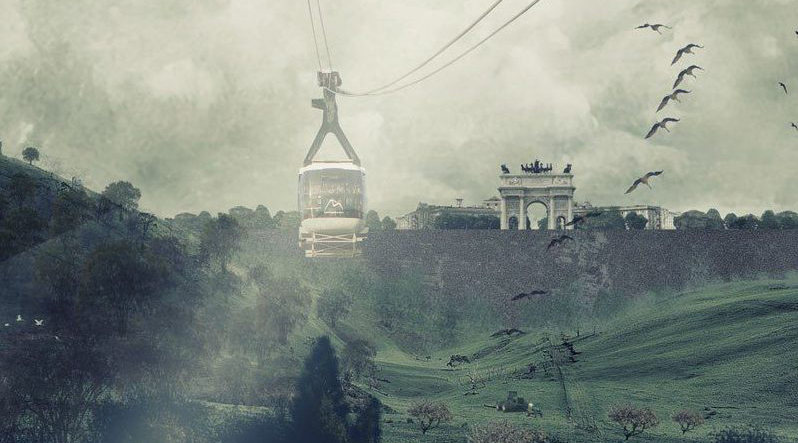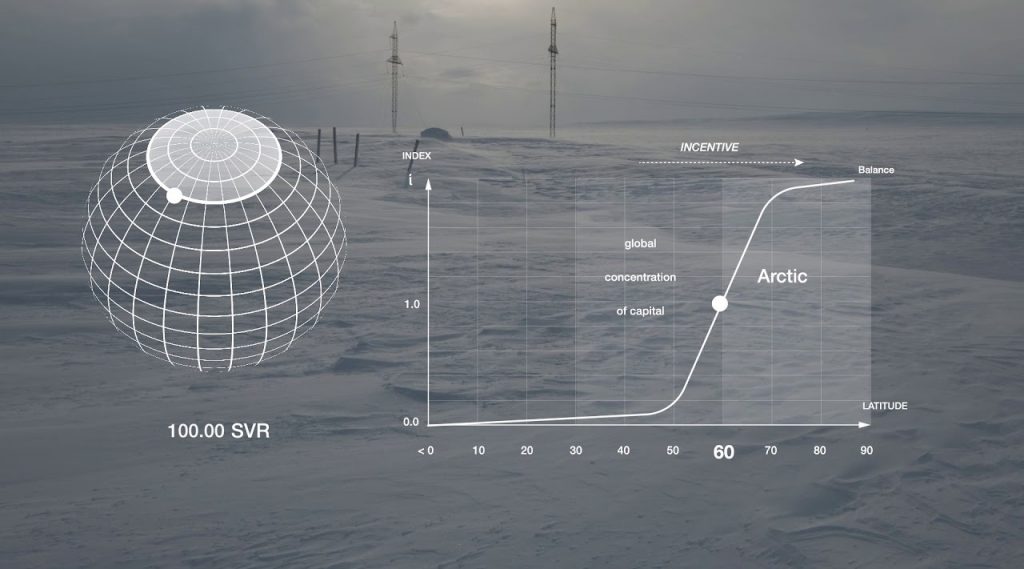EDITOR’S NOTE: The following is an excerpt adapted from “Another Architecture for the Environment,” the introduction to Geostories (ACTAR, 2018), a book by Design Earth which argues for new architectural representation techniques and planetary accounts as tools of making sense of complex environmental systems.

We live in an epoch shaped by extensive shifts in industrialization, with environmental risks and consequences felt at a planetary scale. On graph after graph, metric after metric—population growth, species extinction, particulate matter in the air— changes are accelerating precipitously. Paradoxically, while the threats are serious, we remain little mobilized in part because of the “abysmal distance between our little selfish human worries and the great questions of ecology.”1 If we are worried once again that the sky may be falling on our heads, how is it that we have done so little about it?
The environmental crisis can be seen not only as a crisis of the physical and technological environments; it is also a crisis of the cultural environment—of the modes of representation through which society relates to the complexity of environmental systems. Climate change may be hard to grasp because its geo-graphic representation is overly abstracted and unapproachable. People observe daily weather changes but they do not perceive climate, a phenomenon that is, in its modern definition, a statistically created object of investigation with a long-term assessment period. Furthermore, the weather is experienced locally, while understanding the global effects of climate change would require perceiving the world as a whole.2 How do we think about something as intangible and invisible as the climate—especially as the language of scientific expertise can be misinterpreted, sometimes deliberately, by journalists and those working as “merchants of doubt” on behalf of industry interests?3
Geostories springs from the conviction that climate change demands urgent transformations in the ways we care for and design the Earth, moving away from a visual rhetoric of crisis and politics numbed by “matter of fact” aesthetics. Geostories proposes an “architecture with externalities” that brings into representation—into aesthetics and politics—those things, spaces, and scales that are erased from the geographic imagination. The prefix “Geo-” engages the Earth as a grand question of design: a site, scale, and aesthetic condition. As a suffix “–stories” addresses matters of the Earth in speculative scenarios of technological environments, such as space debris, ocean acidification and deep-sea mining, soil erosion, air pollution, freshwater shortage, and a host of other socio-ecological matters. If such environmental issues are incomprehensible in their scale, their complexity, and their duration, then perhaps it is through techniques of representation that they can be made legible to the senses.
In an epoch where the rapid influx and rapid distribution of information makes experiences of the world nearly impossible to communicate, a story does what infographics cannot. Beyond documentary descriptions, geostories deploy a narrative sensibility to engage the conditions surrounding us. This is in part because stories can help us give meaning to what otherwise would be an illustration of the utterly unbearable scale of events occurring around the globe and across time. Stories do not rally readers to a cause, nor do they call upon them to make lifestyle adjustments, but rather they entreat their readers to envision threats and opportunities together and offer them the means by which to begin to care and respond. On matters of the environment, the myth is a particularly effective means for storytelling in times of trouble. Myths connect to and magnify the cultural and political worlds they engage. Like most stories, they come at truth through the imagination; they describe or explicate a here-and-now that is difficult to tell and hear in other ways. Myths counter the stories of industrial capitalism with an even more fantastic narrative machine that tells truth to realism. They ascribe agency where it is hard to assign causality.
In Donna Haraway’s SF practice–her term for “science fiction, speculative fabulation, string figures, speculative, feminism, science fact”–Haraway reminds us that it “it matters what matters we use to think other matters with; it matters what stories we tell to tell other stories with; it matters what knots knot knots, what thoughts think thoughts, what descriptions describe descriptions; what ties tie ties. It matters what stories make worlds, what worlds make stories.”4 We might add that it matters what drawings we draw to inscribe the earth.

Architectural drawing is a device that brings the Earth into matters of concern; it makes visible absent things, synthesizes sciences and scales of knowledge on complex environmental issues, and engages actors and scales otherwise unaddressed. A drawing is an argument about the world; it is at once descriptive, synthetic, critical, and always speculative. Drawings make worlds; they encompass scales linked to brief organic lifetimes and the immensity of geologic time. They are also important in part because of the other drawings that they could make possible. Much like storytelling, drawing is always re-drawing—borrowing, misusing, appropriating. They matter for our disciplinary and political futures, as educators, designers, and citizens.
Drawings argue through the techniques they use and points of view they choose. The section drawing, for instance, counteracts the abstract Earth of aerial mappings, diagrammatic flows, and soft perspectives. Its orthographic projection plane produces the vertical territory. The section goes beyond the isolation of the domains and sciences of the Earth to project a synthetic drawing that provides an opportunity to reimagine the relations of geological and architectural forces at a planetary scale. Axonometry is another anti-perspective mode of representation that privileges a typological planetary imagination. The axonometric projection is archetypal and ungrounded. It makes totality thinkable, an impossible view for a mere mortal but a necessary outlook to reckon with the cognitive and affective dissonance of climate change.

In the twenty-first century, the ability to comprehend and relate to geological strata, ocean acidity, geostationary orbit, and beyond hinges on the production of stories, cabinets of wonders, rituals, and miniatures that contain the magnitude of the Earth and encapsulate that which scientific rationalization alone has failed to communicate. Beyond a symbolic surrogate of the totality, such microcosm also channels wonder and marvel to create an experience of the world beyond the strict values of the economy. The importance of such wonder-charged experience should not be overlooked when conceiving planetary relationships anew. After all, environmentalism is foremost a protest on behalf of values, an engagement with the world beyond the tunnel vision of “resourcism.” And it is tempting to think that such attention to wonder can make us care. Through Geostories’ many worlds in miniature, we can begin to see the planet.
1 Laura Collins-Hughes, “A Potential Disaster in Any Language: ‘Gaïa Global Circus’ at the Kitchen,” New York Times, September 25, 2014.
2 Quoted in Antonia Mehnert, “Climate Change Futures and the Imagination of the Global in Maeva! by Dirk C. Fleck,” Ecozone, vol. 3, no. 2 (2012): 28.
3 See Mike Hulmes, “Why we Disagree about Climate Change” Why We Disagree about Climate Change: Understanding Controversy, Inaction and Opportunity (Cambridge, UK: Cambridge University Press, 2009); Naomi Oreskes and Erik M. Conway, Merchants of Doubt (New York: Bloomsbury Press, 2010).
4 Donna Haraway, Staying with the Trouble: Making Kin in the Chthulucene (Durham: Duke University Press, 2016), p.12.



